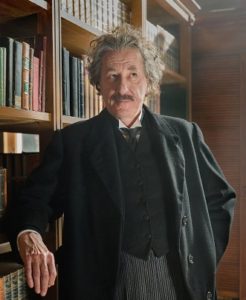
From acclaimed executive producers Ron Howard and Brian Grazer comes this brilliant period television series that depicts Albert Einstein in his early years in the 1800’s, as well as his later years during the 1900’s. The National Geographic series known as Genius was created by Noah Pink and Kenneth Biller, which stars Geoffrey Rush, Johnny Flynn, and Samantha Colley. The show is based on the book by Walter Isaacson entitled Einstein: His Life and Universe.
There are many facets in achieving a specific look to every television series, especially in displaying the period set in the 1800’s and 1900’s. Achieving this authentic imagery was no easy task, it took a vision and entire team to make it work. Only through the vision and key contributions of cinematographer Mathias Herndl, production designer Jonathan Lee, costume designer Sonu Mishra, hair department head Fae Hammond, and makeup department head Davina Lamont could both the 1800’s and 1900’s be recreated.
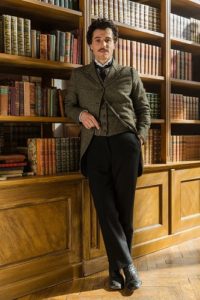
Inspirations and research for the team came about through a multitude of photographs, old books, documentaries, period pieces, imagination, and other techniques.
Herndl explained, “We were trying to figure out how to use light to show the period. It’s important for that time. We were looking for ways to use light and break light. We tried to create a lot of the look in camera. We wanted it to feel natural and practical, and naturally motivated. We didn’t want the show to feel over lit or over produced. On location photography helped with the lighting setup as we used windows and practicals. I was very keen on lighting the two windows to keep the naturalistic flavor. We also augmented smaller fixtures. This worked well, rather than doing large lighting setups.”
Lee added on, “It was a period show obviously. We didn’t make it overly stuffy. We were to embrace colors. The colors of the buildings were to be quite strong. We were going for a more desaturated look. We had a visual start for each country. The story went through many countries.”
The locations and sets played an integral part of the series as well. The production designer explained that majority of the sets were actual locations. They had over 600 locations in the show, including some incredible settings in the Czech Republic. The exteriors were shot on location and were extremely difficult to find. The high-end interiors were also problematic to pinpoint. Einstein’s apartment in Berlin was one of the more challenging interiors. Even with the locations, around 40 sets were built in the studio.
The costume department supplied a collection of garments to enhance the appearance for Genius. Over 200 costumes were created in a span of 6 months for the show and quite few were rented from Italy and the United Kingdom. The material used was natural fabric such as wool, cotton, linen, and silk. They even recreated the major difference in clothing between the United States and those in Europe that demonstrated social status.
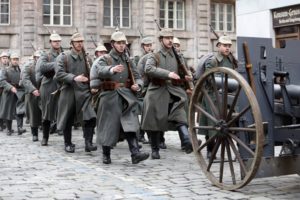
Mishra explained the difference, “The main thing were the fabrics, colors, and the bust. Europe was more casual, relaxed, and open minded compared to the Heidelberg University. Initially what we did before the War, we used dark tones for Heidelberg, Germany. We used lighter colors for the United States such as greys. Also used brown and earthy tones in Serbia to make it look aged. Mileva’s costume changed drastically from 1896 to 1934 because the hem lines were becoming lower, shorter, and started losing the hip. The style changed from the big bustle and corset, and got into the hour glass shape towards [the] end of the 1800’s. In the 1930’s, long skirts were popping in, being a more slender style of dress. For men, it was very gradual because men’s costumes didn’t change much from the 1890’s and 1930’s, besides becoming more casual. Clothes were pretty much the same, except the buttons changing up a bit. Niche wear such as light clothing was worn in Europe during the 1930’s and 1940’s.”
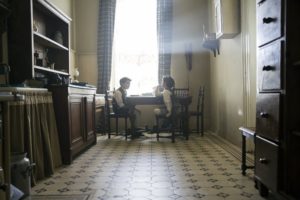
The makeup helped transform the actors Flynn and Rush into looking like the real Einstein of young and old. It took about 2 hours to apply the makeup on and about 3.5-4 hours in total with prosthetics. Every character in Genius was brought to life through the application of makeup, bringing history out of each person as they resemble a historical figure and their characteristics. The obstacle for the makeup department was the ever changing look of the characters older to younger and vise versa.
The look of Genius was given an extra dimension through hair piece wigs, creating unique characters through different hair looks, hair lines, eye brows, texture, color, and weight. Every single actor in the show had their own hair style, down to unique hair lines, adding detail to the character they were playing.
The integration of the lighting, camera, production design, locations, sets, props, costumes, makeup, and hair–all these different elements–uniformly working as a single unit is how they generated the masterfully recreated 19th/20th century look in Genius.
Herndl explained, “To get the piece to look 1800’s and 1900’s, production design played a major role. We moved around so much.”
Lee mentioned, “It was a process really. Working with Ron Howard and the director of photography. It was a process of fine tuning the sets, architecture, fabrics, curtains, carpets; and certain colors worked very well. It was a very creative process.”
“It’s vital with colors, dress, Production Design, fabric, and hair line. Jonathan and I previously worked together before,” said Hammond.
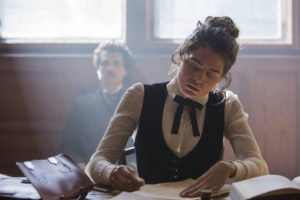
Lamont added “We would talk to one another about the look of the characters, especially the hair. The costume designer and I were thinking as one, as makeup and costume played a big role together. Major collaboration with hair and costume. Didn’t really have to change much regarding makeup, because the cinematographer and I were on the same page.”
“Worked really closely with the cinematographer and production designer. I looked at locations from the production designer. I knew what locations would look like and what colors would match so the costumes would balance out. Knew what Mathias was doing regarding cinematography, so there were no surprises. We would exchange information, we got along well. We were all in harmony and it was for the best of the show,” Mishra finished.
Genius has been renewed for a second season.





